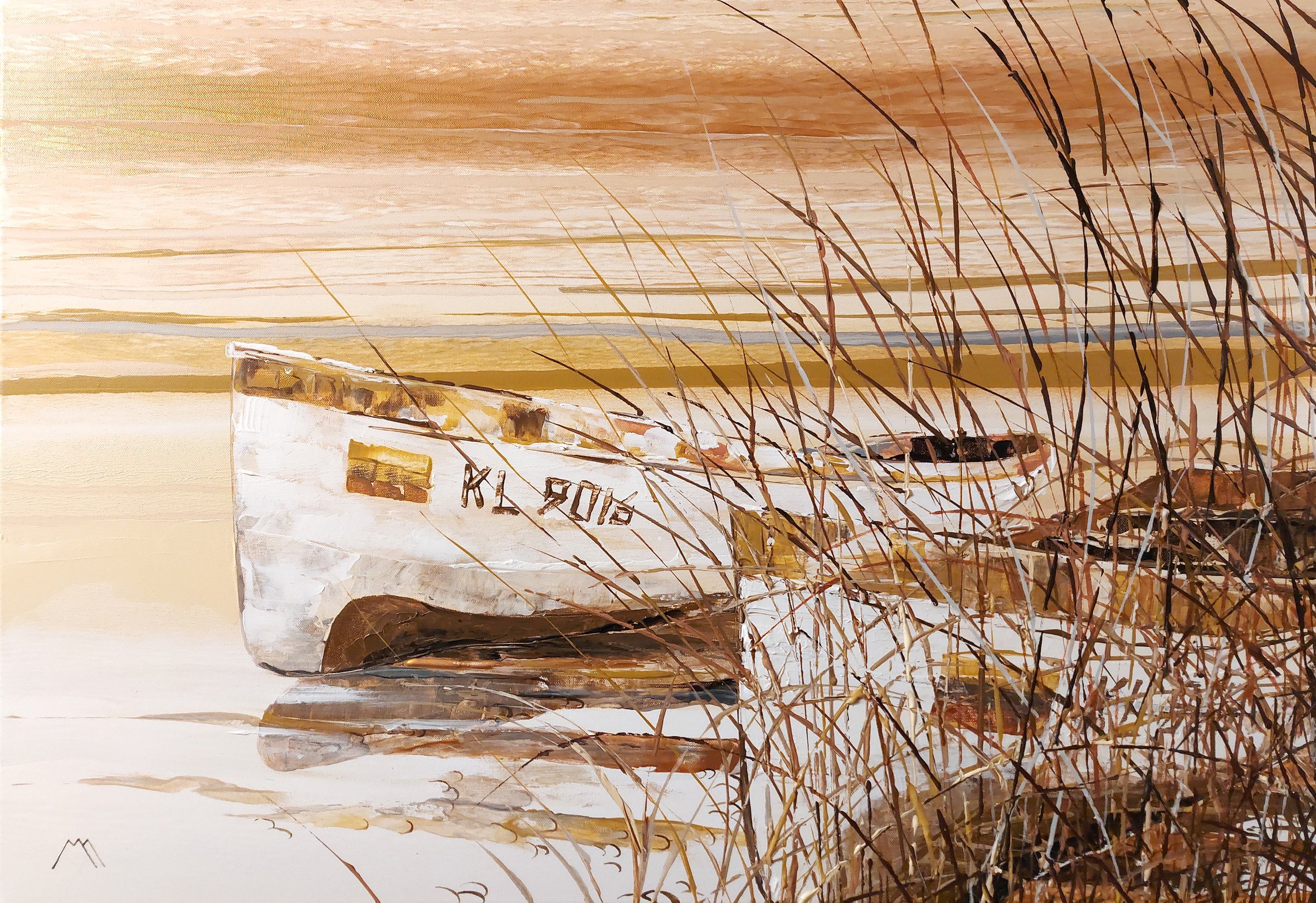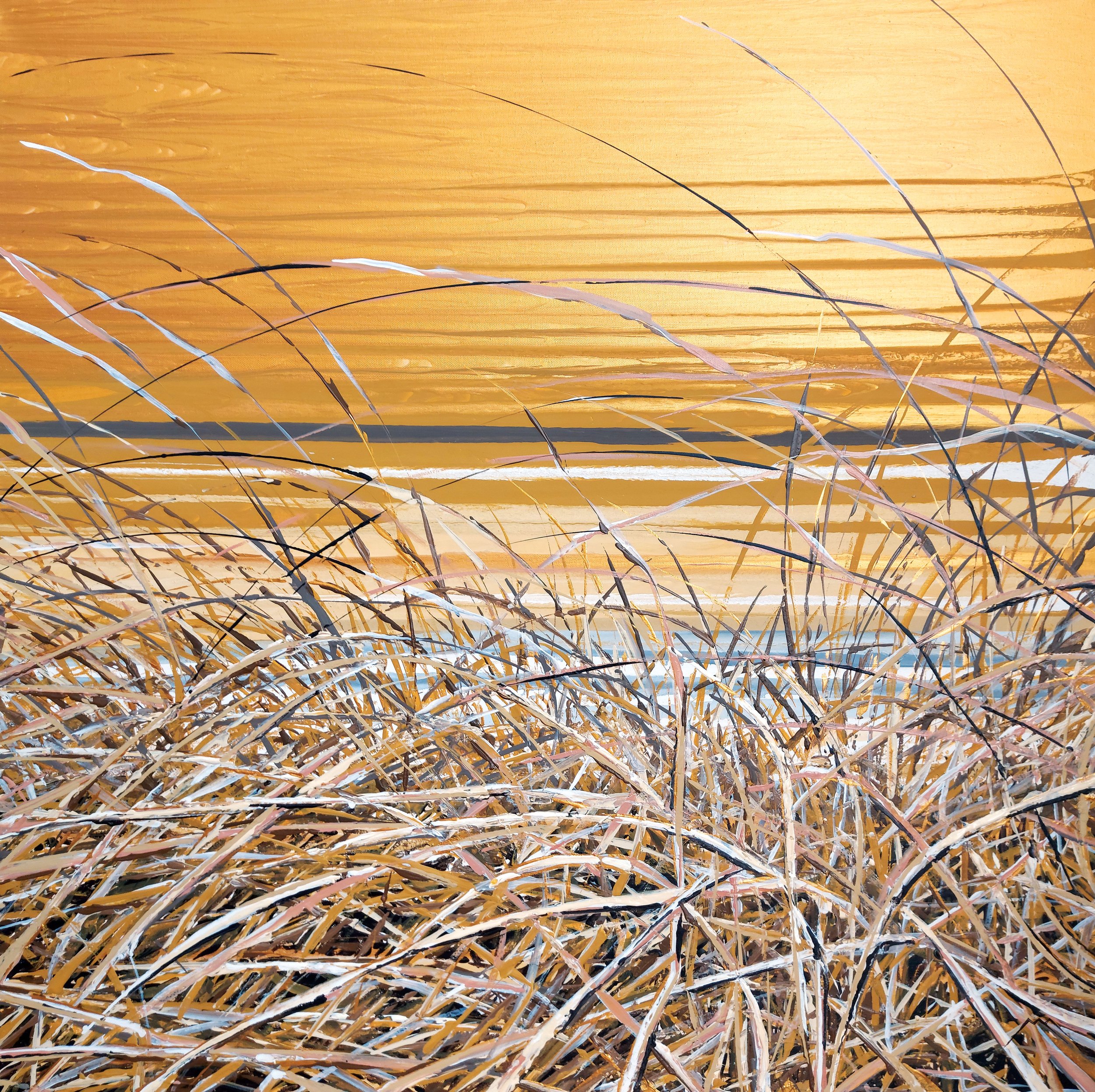10 Questions with Marius Morkūnas
Marius Morkūnas, a creator of the young generation, was born in 1976 in Klaipėda, Lithuania. Creativity accompanied him from early childhood, and at the age of five, a strong attraction to art manifested itself in kindergarten. When he started attending an ordinary school, the priority was art clubs, later art school "BRAKO". Already in the 4th grade, Marius Morkūnas entered and studied at Eduardo Balsio art gymnasium in Klaipėda (1986-1995). 1995 - 2001 studied and graduated at Vilnius Academy of Arts, in the Visual Design Department of Klaipėda, visual design art studies, and obtained a bachelor's degree in design arts. He continued his studies at Vilnius Academy of Arts and, in 2001, obtained a master's degree in visual design in the field of arts. Marius Morkūnas has been working in the fields of design, painting, and photography for 23 years.
Marius Morkūnas - Portrait
In 2022-2023 he made painting exhibitions "STOP SILENCE," "STOPPED TIME," and "BETWEEN NATURE AND STROKE." Exhibition works were born through photography, and the artist better feels the colors of nature, the pulse of nature, how the sun rises, and how the shadows fall. All this is conveyed in the painting. Motives characteristic of oriental culture are also reflected in the paintings; also there are bright and sometimes pastel colors, a very common sense of cleanliness in art. The works exude minimalism, single strokes, and stylized lines intertwined into a whole. In his work, the artist likes to paint the ships and seaside, where he himself comes from, to convey the fragility of the sea reeds and the breath of the wind. The majority of the artist's works have water motives, space, and undulations. Works are done using acrylic paints on canvas, ink, and pencil on paper. The influence of design is felt in the paintings, solidity and moderation of details are appreciated here. The artist sets for himself the goal that each work must have peace in itself, so that when you look at it, you can rest spiritually.
At the same time, Marius Morkūnas has been a professional designer. His specialty is a graphic-visual designer, but with extensive experience in the field of design of various profiles: graphic, interior solutions, exterior, spatial projects from paper, non-standard calendars, packaging, and labels. He also worked as a designer of metal products for a forge. Various lamps, bridges, railings, gates, fountains, and sculptures were created.
Marius Morkūnas is deeply engrossed in photographic projects. He likes creative challenges, and uses his photos and paintings to create non-standard advertisements.
Winches at sunset, Acrylic on canvas, 70x100 cm, 2021 © Marius Morkūnas
INTERVIEW
First of all, tell us a little more about your background, and how did you begin making art?
I was born, studied, and worked most of my life in Klaipėda. Later I moved to Kaunas. I knew that I would become an artist as a child, but it was not clear what field I would choose. I was interested in drawing and sculpture even in kindergarten. Later, I started attending kindergarten and school art clubs, and when I entered the Eduardas Balsys Arts Gymnasium, I started liking other subjects as well: design, painting, photography. The sculpture went into the background. All these three directions have remained in my artistic world even now. Design and painting are the main fields, and photography is like relaxation, like therapy for me. However, there are orders to photograph products for catalogs or websites and to create a beautiful brand look, all of which are closely related to design.
You have a background in design. How does it influence your work as a painter?
All areas are connected, for me, because I have been creating and working for 23 years. I combine painting with design and photography in both my postcards and calendars. Through it, I feel colors, shadows, and composition; while creating photographs, I think about where I will apply it in the design, because I will need shapes, textures, and the right angle in a brochure or calendar. Everything in my work connects together. Sometimes, I simply draw a graphic image of Klaipėda city by hand, and later use it with various advanced printing technologies on the covers of books or calendars and in publications. Design and photography helped me get a feel for color, how to adjust and photograph, in many cases, a difficult process - fresh looking food. To make it look tasty and attractive. I know how to get colors, how to mix, and how to get shadows. Knowing how to feel color is very helpful in painting and design. In creativity, for me, one area always complements the other, they always go together.
Boats on the Seashore in Nemirseta, Acrylic on canvas, 70x100 cm, 2022 © Marius Morkūnas
Is there a piece you consider a "breakthrough" in your career?
There is no specific work, but the breakthrough began when I started to paint ancient Lithuanian ships "kurenai". They mesmerized me, and I could see them in my mind from every angle. You just need to put together a beautiful composition and the colors flow freely in the painting. By itself, similar works on the same seaside theme have increased, because it is close to the heart.
Can you tell us about the process of creating your work? What aspect of your work do you pay particular attention to?
Special attention when creating works is to make a special background, if a bad background, I will not make a beautiful work. The background is created in such a way that I can see space and depth in it, and I pour it, paint it, in every way until I see the desired depth of space. Then, seeing the environment, the composition and the theme of what will be painted in it are formed in the mind. Photographs taken over many years have left an archive of images, color combinations in my mind, which are simply painted on the canvas by themselves.
Coast of the Curonian Lagoon, Ink, brush, pen, paper and a little white acrylic, 31x74 cm, 2022 © Marius Morkūnas
Coastal reed snoring, Ink and brush on white paper, 90x38 cm, 2022 © Marius Morkūnas
Your paintings are mostly landscapes. Where do you find inspiration for your work?
Most of the paintings are landscapes. The work is dominated by minimalism, and abstract stylistics. One of my main sources of inspiration is nature; stylized decorative works are dominated by natural and sea motifs. Plant, tree, and bird motifs are stylized; sometimes, they become a sign that gives meaning to my idea and highlights an inner emotion. And sometimes, the decorative aspect is highlighted in them through color and line. Aestheticized images are dominant in works, which form an inseparable unity of emotional coherence and unity of form. Harmony and balance are also reflected in the names of the exhibition works: "Hear the silence", "Stopped time", "Fragility of the line", "Between nature and stroke", "Between stroke and nature", "Living line" and others. The chosen stylistics also testifies to aesthetic attitudes: to immerse yourself in the delicate world of art and nature, to find peace, to reflect on yourself and the environment. Therefore, the therapeutic effect of these works, experienced through aestheticized forms and coloristics, cannot be ruled out. My themes are all somewhat similar, they come back again and again with the seaside, only sometimes I want to improvise, where I can create a graphic image with ink or even watercolor. It's important to use the different techniques you've learned, sometimes you like to mix different styles. And sometimes, there is simply an order to create and artistically convey a port or cargo terminal, and this is done with the help of painting, graphics or spatial details.
What about your colors? You seem to have recurring colors you particularly enjoy using, do they have any specific meaning for you?
Most of the works are painted in earthy colors, browns, grays, yellows, but sometimes I use brighter oranges, reds, and purples for sunsets and evening or morning mood. The colors do not have a specific meaning, maybe they reflect more the mood and impression I want to get in the picture. Sometimes I paint at night, sometimes in the morning. I use mostly 3 colors in the picture with their infinite shades, then it is not so variegated, colorful and it is better to get the desired result. I use green and cool blues the least. They have less comfort and peace in themselves.
Evening in Dreverna, Acrylic on canvas, 100x100 cm, 2022 © Marius Morkūnas
Golden dunes by the Baltic sea, Acrylic on canvas, 100x100 cm, 2022 © Marius Morkūnas
What do you think about the art community and market
The art community and market is as it should be, modern, broad, colorful with its own styles and characters. To be visible in all that creation, you need to have your own style, character, theme, and that's the only way you'll be noticed. Nothing good will come of doing things as everyone else does.
There's a lot of painting work on the market these days, how do you differentiate yours from the rest? What do you feel makes your work unique and truly your own?
Each artist creates works in his own way and only in his own style to be seen among others. I use mainly acrylic pouring and dripping, a technique that creates the beauty of the casting itself, just as in nature the colors of the clouds merge with the sea. I try to reproduce this in the painting naturally as given by nature. I have not found such examples of space painting, all the artists I have met say that such a style has never been seen anywhere. With the help of lines, the poured canvas creates a unique space that does not even need a horizon, it is assumed differently in each person's mind.
Old wooden Šventoji bridge in the fog, Acrylic on canvas, 100x100 cm, 2022 © Marius Morkūnas
What are you working on now, and what are your plans for the future? Anything exciting you can tell us about?
Works continue in all my three art directions, painting, design and photography. As far as painting is concerned, the main work is now going on with exhibitions and painting new works, implementing ideas on canvas. At the moment, there were 3 personal exhibitions "Hear the silence", "Stopped time" and the third personal exhibition is currently taking place in Vilnius, "Between nature and stroke". There were quite a few exhibitions with the group of "Blue Art" painters, at least 6 exhibitions in half a year. We do them constantly in various areas throughout Lithuania. The list of next year's exhibitions has already been planned, all that remains is to implement it. The themes of the works in the exhibitions are diverse, but everything is somehow related to nature and the area where we have become. I do not exhibit abstract works and works done on paper with ink in such exhibitions. All the other works that are shown in the exhibitions lead to the general cycle of the peace of nature, which is divided into older works, medium and recent ones. In the future, I plan to do a cycle of more abstract works and a cycle of graphic ink works on paper. There are plans to make a cycle of urban themes and female plastic in a similar style.
What do you wish to accomplish this year, both in terms of career goals and personal life?
This year's plans are many and varied. Exhibitions, plein airs are planned all over Lithuania for all years, some of them reach next year. Many beautiful painting moments and presentations are expected with the "Blue art" group. We have plan for a weddings in the autumn, trip to Krakow (Poland) and a little bit around Lithuania. You just need to catch up in time everywhere and enjoy this day.























